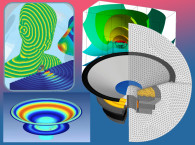Free Field Technologies (FFT), an MSC Software company, announced the release of Actran 16. The new release provides breakthrough technologies for achieving superior performance in acoustic, vibro-acoustic and aeroacoustic simulations. Key highlights of the Actran 16 release include new audio and electroacoustic capabilities; acoustic propagation in huge domains and at high frequencies; new aeroacoustic modeling capabilities for fast virtual testing; and co-simulation with other MSC Software tools for multi-discipline analyses.

Actran 16 features several enhancements allowing the easy and fast evaluation of loudspeakers installed in large and complex systems such as a complete car door. In this release, Thiele&Small electro-magnetic parameters (i.e. the force factor, the voice coil DC resistance and the voice coil inductance) can now be directly input into an Actran model. This feature together with enhancements related to the link between loudspeakers and structural modes allows the easy evaluation of audio performance of the complete system. Finally, a new piezo-electric component is now available for modeling both the direct and converse effects of certain materials.

Acoustic propagations in huge domains and at high frequencies are now possible within few hours thanks to the Actran DGM code which now supports GPU acceleration. This allows users to simulate cases that were previously difficult such as ultra-sonic parking sensors and a full truck exterior acoustic propagation at high frequency.
Aeroacoustic typically relies on long and computationally expensive unsteady CFD simulations. Actran 16 features the new SNGR module which synthesizes the noise sources from inexpensive steady RANS solutions allowing users to perform many virtual tests within few hours. Actran 16 also features the pellicular mode decomposition, a unique technique which extends the well-known wave number decomposition for automotive side-window aeroacoustic analyses, for example. It is now possible to distinguish the acoustic and hydrodynamic contributions on non-rectangular and non-planar surfaces.
The Actran time domain solver has been improved both in terms of solution capabilities and its integration with other MSC Software codes. Now Actran can read Dytran output files for performing acoustic analyses of problems involving Fluid-Structure interaction such as noise of fluid in a tank. Moreover, the interface with Adams, the multi-body dynamics (MBD) solution of MSC software, has been enhanced. Several ease-of-use improvements have been delivered allowing MBD engineers to directly access acoustic results and to listen to their design thanks to audio files automatically generated.

Many ease-of-use and performance enhancements have also been developed in this software release. Specifically, the graphical user interface and its meshing tool include several new features allowing the rapid creation and manipulation of vibro-acoustic meshes. Moreover, the adaptive meshing technology has been further extended. This technology automatically generates optimal meshes for vibro-acoustic simulations allowing a drastic reduction of the computational time when compared to typical acoustic simulations. Actran has also been enhanced with optimization capabilities. This feature, combined with the scripting capabilities of the graphical user interface, allows performing topological optimization easily and quickly.
“Actran 16 delivers a valuable set of features to the industry,” said Benoît Van den Nieuwenhof, CTO at FFT. “The SNGR feature gives users access to new capabilities like full car exterior aero-acoustics where unsteady CFD computations are not affordable. For tackling higher frequencies and their associated model sizes, Actran features an original and automated mesh adaptivity. The Actran DGM solver leverages the latest HPC environments such as GP-GPUs which dramatically improves the computational efficiency of acoustic radiation analyses for automotive and aerospace industries”.
Free Field Technologies (FFT) was founded in 1998 and is headquartered in Mont-Saint-Guibert, Belgium. An MSC Software company, FFT develops and supports the Actran software suite for acoustic, vibro-acoustic and aero-acoustic modeling.
www.mscsoftware.com | www.fft.be






